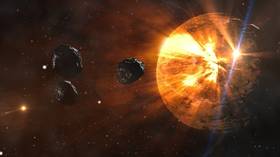NASA and ESA release spectacular updated Hubble image of Veil Nebula (PHOTO)

Using new techniques, scientists have released a breathtaking updated image of the Veil Nebula, the beautiful remains of a supernova which took place 10,000 years ago.
The supernova remnant is called the Cygnus Loop and is the result of the death of a star 20 times the mass of the Sun, which exploded some 2,100 light-years away. The hollowed-out remains of the star stretch out over 110 light-years, having been shaped by a phenomenally powerful stellar wind which blew past prior to the star going supernova.
The wind dispersed initial gas emissions from the star before the resulting explosion lit them up like neon veins stretching out along cavity walls of a gigantic filament of ‘star stuff’.
The operators of the Hubble Space Telescope released the spectacular image in 2015, which was shot with the Wide Field Camera 3 instrument.
Recently, researchers reprocessed the original data using new techniques to produce an even more spectacular image showcasing the celestial interpretation of the phrase, “out with a bang.”
While the image makes for some serious eye candy, it showcases how refined technical processing of data from humanity’s distant probes has become, affording new insights into interstellar processes which create the vast structures across the universe.
In the image, different gases are rendered in different hues: blue for twice-ionized oxygen, red for ionized hydrogen and nitrogen.
The green gases were not disturbed by the supernova shockwave and therefore appear more diffuse as they were allowed to settle.
Also on rt.com A distant star just exploded, went nova and is visible from Earth right nowBy comparing Hubble’s 2015 images with its previous photos of the nebula from 1997, scientists determine that it is expanding at a rate of 1.5 million kilometers (932,000 miles) per hour, or 117 times the diameter of Earth.
Think your friends would be interested? Share this story!













